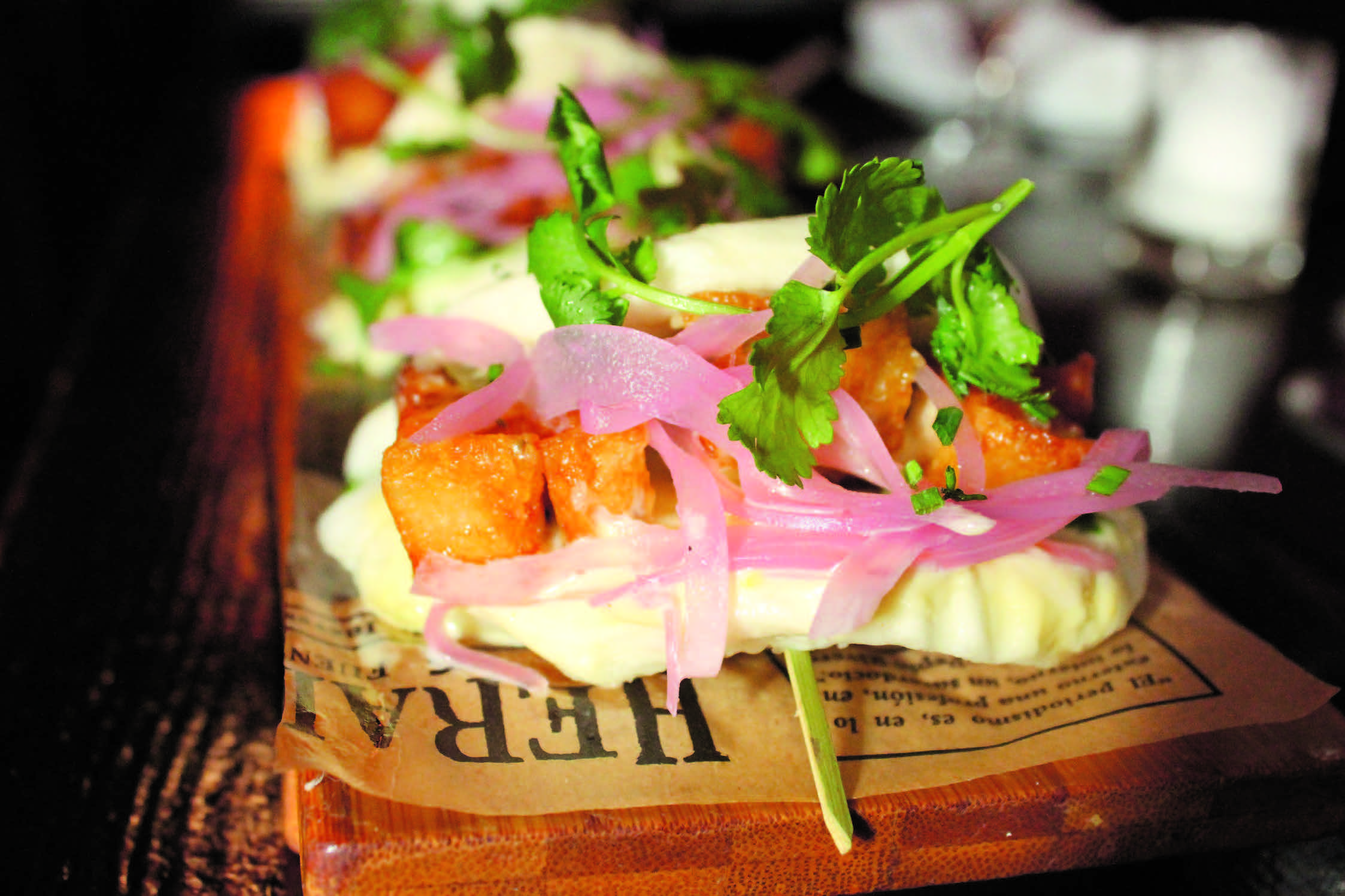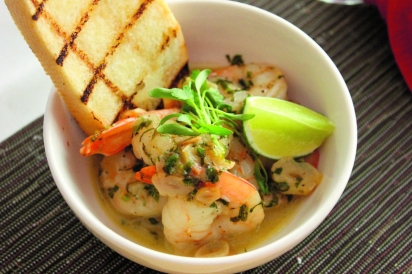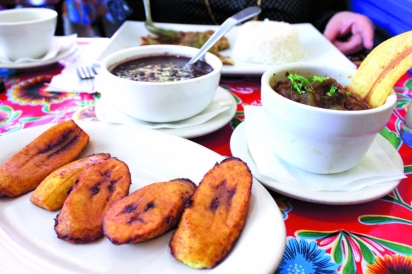MELTING POT: HAVANA ON THE HUDSON
Churrasco isn’t Cuban. Or is it?
Skirt steak, the long, thin cut from the underbelly of the cow, is most associated with South America. That skirt steak with chimichurri, often defined as churrasco? That’s from Argentina.
Churrasco was introduced to a wider audience by Victor’s Café in New York, which opened in the early 1960s. Victor’s Café was—and remains—an influential Cuban restaurant. So here in the States, thanks to Victor’s Café, we began to associate churrasco with Cuban food.
Yet the real Cuban steak is the palomilla, says Maricel Presilla, whose early culinary career included consulting work at Victor’s Café. Presilla is now the owner of two restaurants in Hoboken. (Zafra is more casual and is centered on Cuban food, while Cucharamama reaches from South America, with dishes from Peru, Ecuador and Argentina.)
The palomilla, like the churrasco, begins with an inexpensive cut of meat. “We eat every part of the animal.” But it’s marinated first (garlic, lime, cumin, salt and pepper), pan-fried and served with fried onions. In Cuba, says Presilla, everything is marinated.
The same confusion occurs with yuca fries with cilantro sauce. Yuca may be a traditional Cuban ingredient, but yuca cut into small fries and served with spicy, creamy cilantro dipping sauce is not Cuban. The combination was invented in the States. “People think it’s Cuban and it is not,” says Presilla.
Presilla, in fact, is the creator of yuca fries with cilantro sauce. She dreamed them up in her home kitchen and adapted them for the menu at Victor’s Café in New York and Miami. Her recipe first appeared in Food Arts in 1992. Today, yuca fries with cilantro sauce are ubiquitous on the menus of Cuban restaurants. “A lot of things that you think are Cuban are not.”
But if you’re squabbling about the differences, palomilla vs. churrasco, delicate yuca fries with cilantro sauce vs. thick, fried yuca with a mojo sauce, Cuban or not, you’re missing the point. Presilla, as an historian, a James Beard Award–winning chef and a James Beard Award–winning author, is an unequivocal expert. She is the author of Gran Cocina Latina: The Food of Latin America, which is considered the bible on the topic. Also, she was born in Cuba. And her message is just as unequivocal. It’s not about what separates us, it’s what binds us. In the Americas, we are all, in some way, the product of Iberian colonialism.
The evolution of Cuban food is easily witnessed in Hudson County, which, for more than 60 years, has welcomed wave after wave of Cubans.
In Jersey, the Cuban influence continues to dominate the stretch of geography between Union City and North Bergen known as Havana on the Hudson. The artery is Bergenline Avenue, 4.5 miles that seem to stretch north to eternity. Storefronts with faded signs. Windows boasting 10-cent churros.
Women carving pork haunches. Fruit juices so neon they might melt the plastic of their cups. Smells of fried masa yank your head sideways. Elderly men in pinstripe suits loitering in cafeterias alongside tables of serious young men eating ropa vieja alone and families with smiles trained on trays of pressed sandwiches snaking—at last!—to them. Signs for lengua tacos. Guava shakes. Jugo de naranjilla. Café con leche.
Today, in the Cuban restaurants that dot that landscape, the food is spicier. You see more seafood. More meat. Other Latin American dishes—empanadas, ceviche—have crossed over. Avant-garde Cuban chefs are breaking the rules, messing with mole, riffing with rice flour. What hasn’t changed is this: Hudson County remains a hub of stellar Cuban dining, with dishes that are deeply satisfying, deeply soulful.
Here, then, a few spots along Havana on the Hudson, old and new, with a memorable dish from each.
MI BANDERA: This 200-seat restaurant in downtown Union City sits atop a grocery store on 32nd Street. Sporadic flames leap from the ancient grill at the center of the capacious dining room, open since 1991. The waitress points to churrasco on the menu. “This is good!” she advises, as if disclosing a secret.
Aside from a faint spice blend, Mi Bandera sticks close to the Argentinean method. Come for lunch, and the 10-ounce skirt steaks that hiss madly on grates heated to more than 1,000 degrees cost just $12 (including bread, salad, rice and beans). Julio Franco, owner, notes that the grill needs to be hot to gloriously char the exterior without overcooking the thin cut. His wife, Cardid, mixes a nice cilantro-less chimichurri that gives the rustic steak brightness and levity.
UNION CITY CAFETERIA LA CHURRERIA: Steam coils from our paper cups of café con leche at this family restaurant, which many refer to simply as the Union City Cafeteria. The Cuban sugared coffee is half dark roast coffee, half milk. We also have—in the cafeteria where for 30 years blenders have whirred and wait staff have bustled—a corner view of the crowds on Bergenline, ebbing and flowing. The tres leche, in a perfect square, is topped with whipped cream and swims in a quarter-inch of condensed milk. The cake doesn’t even get a plate; it fills a plastic take-out container. The first bite is light and creamy and sophisticated in its simplicity. This was made to be chased with a long swig of milky coffee. Outside, the world passes by.
COCO HAVANA: The recently remodeled restaurant opened anew in early 2017. Owner Mario Fini is a chief in the Hoboken fire department. The restaurant has a tropical vibe, which deepens at night when a DJ spins and mojitos flow. The shrimp, Mexican whites from the Gulf, are mounded in a light garlicky broth and filigreed with micro cilantro. A round of grilled bread from Teixeira’s Bakery makes for prime soaking. (If you’re about in Hoboken before sunrise, you’ll see a Teixeira’s truck circulating to Cuban eateries.) Though The Old Man and the Sea may imply otherwise, fish isn’t big in Cuba. The fusion menu, which also features ingredients such as kale, chipotle and wild-caught salmon, speaks to the cuisine’s capacity for change.
THE CUBAN RESTAURANT AND BAR: In this subterranean spot with vibrant art on the walls, Chef Alexis Lahens executes both traditional Cuban cuisine and, as he defines it, “interpretations of tradition.” Lahens’ family comes from Cuba. He cooks boliche (Cuban pot roast) and traditional staples. But his education, at culinary school and in seafood restaurants and Asian eateries, introduced him to international flavors. Lahens does a pork dish that pulls from the East. He bakes bao buns (Chinese), fills them with scallion mole (Mexican) and shreds of suckling pig roasted Peking duck–style. For this, he seasons a whole pig, half Asian (cinnamon and star anise), half Cuban (cumin and oregano). The buns are an inventive and flavorful preparation even for a young Cuban chef who pickles ramps and drizzles truffle honey on eggplant fries. “When people think of Cuban food, they think of rice, beans and a protein,” Lahens says. “And that’s great, but I need to do something different.”
ZAFRA: Maricel Presilla emigrated from Santiago de Cuba in 1970. She has a doctorate in Medieval Spanish history and has worked and written extensively on Latin American foodways. She has won three James Beard Awards. At Zafra, the past and present of Cuban food in Hudson County roll into one. Presilla has a reputation for artfully looping flavors and ideas together from all over the Spanish-speaking world. Zafra does this less than her restaurant down the street, Cucharamama. Even so, some of Zafra’s dishes reach. The one that comes to our limegreen–clothed table now triangulates Cuba, South America and India.
Yuca fries with sauce “a la Presilla” is named after Presilla because she invented the dish while consulting for Victor’s Café, an influential Cuban restaurant in New York. The dish has since spread to Cuban restaurants across the country.
“In several Latin American countries, cooks cut their yuca like French fries,” Presilla explains. “That is not the way Cubans prepared fried yucas.” (Cubans typically cut the boiled tuber into large chunks.) Presilla decided on long, flat fingers of fried yuca and a cilantro dipping sauce because she wanted something other than traditional mojo. Her cilantro sauce was inspired by a chutney she tasted in Meerut, India. The sauce brings coolness and soft chile heat with garlic and lime juice tempering the creaminess, cilantro lending some tang and all the flavors dovetailing with the hot fries—which we have already eaten!
LA ISLA: Opened in 1970, La Isla is the oldest Cuban restaurant in Hoboken. Omar Giner has fried papa rellenas for Guy Fieri and has beaten Bobby Flay in a throwdown with his guava French toast. Yet it’s the black beans at La Isla that confound. How can such flavor be extracted from such a humble ingredient? Under lofty ceilings and lively tunes we ponder this question, the bowl of soupy beans and white rice getting increasingly empty.
“It’s pretty straightforward,” Giner says. He starts with a sofrito of garlic, onion and bell pepper. The beans are cooked separately, and the sofrito is stirred in at the end, followed by a splash of vinegar. “Cuban food is simple and down to earth,” Giner says, “There’s not a lot of stuff going on, but there is a lot flavor.”






